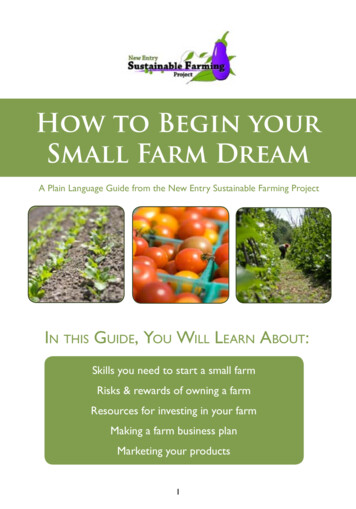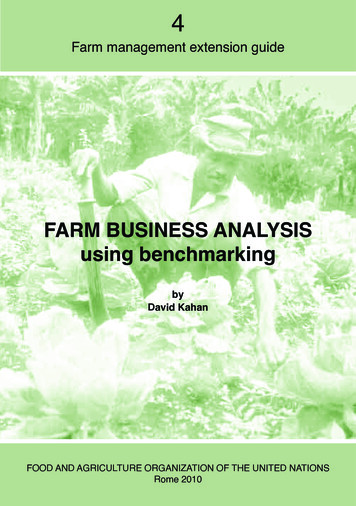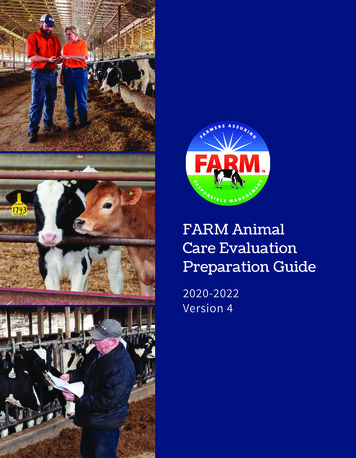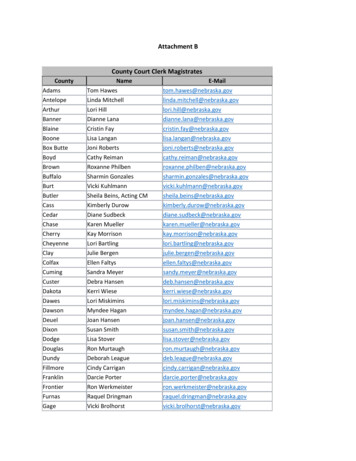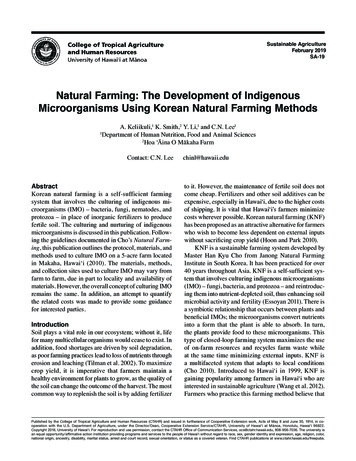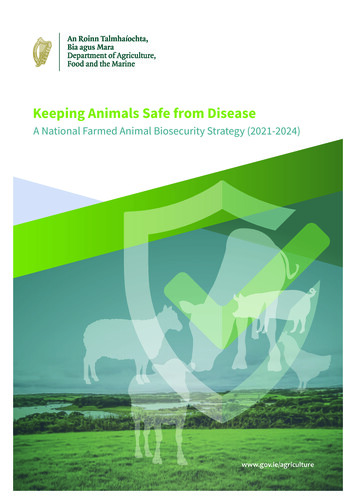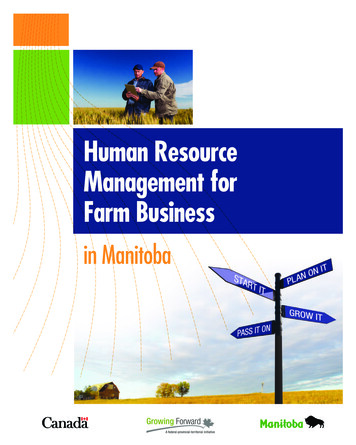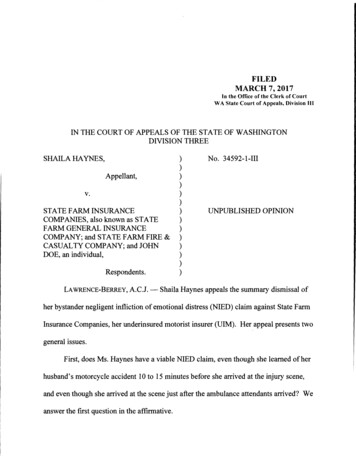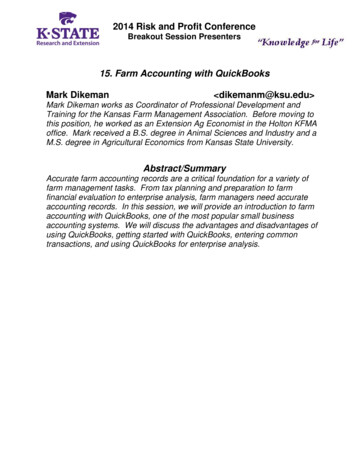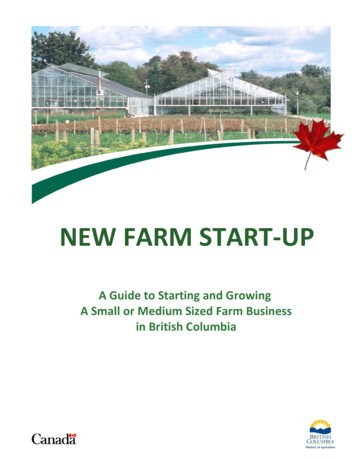
Transcription
NEW FARM START-UPA Guide to Starting and GrowingA Small or Medium Sized Farm Businessin British Columbia
NEW FARM START-UPA Guide to Starting and Growing aSmall or Medium Sized Farm Businessin British ColumbiaJune 2011Revised July 2021Growing Forward, a federal-provincial-territorial initiative
INTRODUCTIONWelcome to the farm community and congratulations on choosing farming for your new business enterprise.Agriculture provides many opportunities to start and grow a farming enterprise that meets your needs andinterest. Many of the medium and large scale farming operations, supporting several families today, startedsmall and grew over time as skills developed, markets were refined and demand for their product increased.And farming is a good small business. Farms tend to stay in business longer than other small businesses andfarms tend to be transferred to the next generation more frequently than other small businesses.Agriculture has been referred to as the most essential job in the world1:In order to succeed in farming you have to know when to sow, how to grow, when to harvest and how to sell.And, you have to do it while keeping one eye on an unpredictable mother nature and the other on capriciousand unforgiving markets. It isn’t easy. Growing food is not only the basis of human survival and therefore themost essential job in the world, but it is one of the most complex.To provide the best opportunity for success in your farm business, it is important to identify the type of farmenterprise that best fits your passion, your interest, your family situation and the resources you have available.This guide is designed to help you ask the appropriate questions, in an orderly way, that will help you developa farm business enterprise with the highest potential for success.The guide begins by exploring the passion, interest, skills and resources you bring to your farm enterprise.You may be keen to jump right to the section on developing a farm enterprise plan but are encouraged totake the time to first assess your passions related to farming and what assets you bring to the farm business.Farming provides many ancillary benefits but as one farmer noted:“Farming as a business is a wonderful lifestyle, farming as a lifestyle is a horrible business.”The ancillary benefits come from a successful farm business. Business structure, planning and analysis areimportant parts of your farm business enterprise. The business questions have been placed up front in theguide because they should be considered early in your farm development process.You will note that the section on ‘what can you sell?’ comes before ‘what can you produce?’ Producing aproduct, before identifying a market, usually results in you selling your product at the commodity (lowest)price. As a small or medium sized start up farm, it is unlikely you can produce as efficiently as existing largescale farms. One of the critical factors for success will be identifying and developing your specific marketbefore and during production.There is a lot of information on the internet related to farm business planning. Internet references are imbeddedin the document and summarized in the appendix. This guide supplements the general business planningguides by adding the B.C. perspective as well as hints and insights into how to best develop your farmenterprise plan. The more you are involved in developing and personalizing the information that goes into theplan, the better prepared you will be to start your farm enterprise.1From A Century of Achievement , A History of the Ministry of Agriculture, Fisheries and Food. 1996i
Internet references within the body of the guide, and summarized in the appendix, focus on sites supported bygovernment agencies or universities. It is very important to consider the applicability of this information to thespecific growing conditions on your farm and if you go beyond these sources, it is important to alwaysconsider the credibility of the source of the informationThe guide ends with a framework for building your farm enterprise plan. This plan will provide a benchmarkwith which you can measure the progress of your farm enterprise, and will also provide the base informationyou will need if you are seeking financing outside your farm team.A 50 page guide is a lot to cover in one reading, however, the information is presented in the order that youshould consider in developing your farm enterprise. The guide also acts as a resource to help frame your plansfor future growth. When thinking about your farm business, you are encouraged to continue to ask questionsin the same order– what can I sell, what can I produce and will it make my farm enterprise more successful?Good luck and again welcome to the farming community.ii
TABLE OF CONTENTSINTRODUCTION. iTABLE OF CONTENTS . iii1WHAT DO I BRING TO THE FARM BUSINESS ? . 11.1 PERSONAL INTERESTS . 11.2 TASKS ASSOCIATED WITH FARMING. 11.3 ASSESSING SKILLS AND KNOWLEDGE . 21.4 FIVE TRAITS OF SUCCESSFUL FARMERS . 21.4.1 Passion . 21.4.2 Marketing. 21.4.3 Ingenuity, Creativity and Adaptability . 21.4.4 Perseverance . 21.4.5 Continuing Education and Networking . 31.5 CAPITAL RESOURCES – LAND, EQUIPMENT, FINANCIAL RESOURCES . 31.5.1 Access to Land . 31.5.1.1 Already Own or Are Planning to Purchase . 31.5.1.2 Accessing Farmland Through Leases and Other Arrangement . 4Leases of Private Farm Land – Short Term . 4Lease of Public Farm Lands or Land Trusts . 4Farm Mentor / Transfer Arrangements . 41.5.2 Access to Farm Equipment .51.5.2.1 Buying Used Equipment. 51.5.2.2 Buying New Equipment. 51.5.2.3 Leasing . 51.5.2.4 Borrowing / Bartering for Equipment. 61.5.2.5 Contract Farm / Tractor Work . 61.5.3 Financial Resources . 62MARKETING OPPORTUNITIES – WHAT CAN I SELL ? . 72.1 GENERAL APPROACHES TO SELLING FARM PRODUCTS – MARKETING CHANNELS. 72.1.1 Formal Marketing Schemes . 72.1.1.1 Supply Managed Commodities. 72.1.1.2 Central Selling Desks . 82.1.2 Contractual Arrangement with Marketing Agencies, Co-Operativesor On-Farm Producer / Processors . 82.1.3 Auctions – Particularly Livestock . 82.1.4 Direct Marketing . 92.1.4.1 Direct to Retailers (Wholesale) . 9Small Meat Markets . 9Local Farm Market Stores . 9Restaurants . 9iii
2.1.4.2 Direct to Consumers (Retail).9Road Side Stand or On-Farm Store .9Farmers’ Markets . 10Community Supported Agriculture (CSA’s) . 10Farm Direct Sales – Without Roadside Stand . 102.1.5 Utilizing Web-Based Tools . 112.1.6 Additional Regulations Connected to Direct Marketing . 112.2 PRODUCT DIFFERENTIATION AND COMPETITIVE ADVANTAGE . 112.2.1 Product Differentiation and Competitive Advantage. 112.2.2 Identifying Direct Market Opportunities . 122.2.2.1 Skills and Resources What skills and resources do I have that may give me a competitive advantage? . 122.2.2.2 Farm –What types of products might be uniquely suited to be produced on my farm property? . 122.2.2.3 Community –What types of products and services might be in demand in my community? . 132.3 EVALUATING THE MARKET OPPORTUNITY AS A BUSINESS OPPORTUNITY .132.3.1 How Secure is Your Competitive Position? . 132.3.1.1 Substitutes . 132.3.1.2 Technology . 132.3.1.3 Ease of Entry. 142.3.1.4 Ease of Exit . 142.3.2 Defining the Characteristics of the Market for Your Product . 142.3.2.1 How Big is the Target Market?. 142.3.2.2 What Portion Can You Capture? . 152.3.2.3 What Price Will You charge for Your Product? . 152.3.3 Is the Market Opportunity a Business Opportunity?. 163WHAT CAN I PRODUCE ? . 173.1 ASSESSING YOUR LAND CAPABILITY . 173.1.1 Soil Capability. 173.1.2 Water – Too Much Too Little or Just Right? . 183.1.3 Climatic Characteristics . 193.1.4 Topography . 193.1.5 Identifying Potential Regulatory Limitations . 193.1.5.1 Local Government . 203.1.5.2 Environmental Protection . 203.2 PRODUCTION INFORMATION. 20iv
4OTHER FARM AND BUSINESS DECISIONS .234.1 BUSINESS STRUCTURE . 234.2 HUMAN RESOURCES. 244.2.1 Family / Friends . 244.2.2 Low Cost / Ad Hoc Human Resources . 244.2.2.1 WWOOF’ers. 244.2.2.2 Internships . 254.2.3 Hired Help . 254.2.3.1 Students . 254.2.3.2 Seasonal Farm Workers . 254.2.3.3 Permanent Full Time or Part Time Staff . 254.2.3.4 Outside Expertise to Supplement Your Skill Set. 254.2.4 Retaining Human Resources . 264.3 BUSINESS RISK MANAGEMENT . 264.3.1 General Commercial Liability Insurance . 274.3.2 Production Insurance . 274.3.3 Government Programs ( Provincial/Federal Shared Programs ) . 274.3.3.1 Agri-stability . 274.3.3.2 Agri-invest . 274.3.3.3 Agri-recovery . 274.4 SOCIAL RESPONSIBILITY. 284.4.1 Governance 101 . 284.4.1.1 Levels of Governance . 284.4.1.2 Tools of Governance. 284.4.1.3 Your Responsibility Relative to the Different Governance Tools . 284.4.2 General Guidance to New Farmers . 294.4.3 Right to Farm . 304.5 SUPPORT SYSTEMS . 304.5.1 Education / Information Source . 304.5.1.1 General Information . 304.5.1.2 Local Information. 314.5.2 Government Programs . 314.5.2.1 Direct Financial Support Programs . 314.5.2.2 B.C. Plant and Animal Health Diagnosis Laboratory. 314.5.3 Local Farm Networking. 314.6 REPORTING REQUIREMENTS .324.6.1 Mandatory Reporting . 324.6.1.1 Canada Revenue Agency (Farm Income) . 324.6.1.2 Canada Revenue Agency (Payroll Deductions) . 324.6.1.3 Work Safe B.C. (Worker Insurance) . 324.6.2 Optional Reporting . 324.6.2.1 Canada Revenue Agency (Harmonized Sales Tax) . 324.6.2.2 B.C. Assessment Authority. 334.6.2.3 Registering A Business Name . 334.6.3 Not Required . 33Business License . 33v
5BUILDING A FARM ENTERPRISE PLAN . 355.1 INTRODUCTION TO A FARM ENTERPRISE PLAN . 35Business Plan Guides . 35Commodity Specific budget Sheets . 35The Basic Components of an Enterprise Plan . 355.2 DEVELOPING A MARKETING PLAN . 365.2.1 Promotional Plan. 365.2.1.1 Target Market . 365.2.1.2 Promoting Your Product . 36Advertising . 36Local Farm Marketing Associations . 36Signage . 37Farm Days / Farm Events. 37Word of Mouth . 37On-line. 375.2.1.3 Estimating Sales . 375.2.2 Maintaining an Edge. 395.3 DEVELOPING A PRODUCTION PLAN . 395.4 DEVELOPING A FINANCIAL PLAN . 405.4.1 Income Statement .405.4.2 Cash Flow Analysis .405.4.3 Balance Sheet.415.4.4 Source and Use of Funds .415.4.5 Farm Taxes.415.4.5.1 Farmland Classification. 415.4.5.2 Harmonized Sales Tax . 415.4.5.3 Farm Income Taxes. 425.5 DEVELOPING A EXIT PLAN .
take the time to first assess your passions related to farming and what assets you bring to the farm business. Farming provides many ancillary benefits but as one farmer noted: "Farming as a business is a wonderful lifestyle, farming as a lifestyle is a horrible business." The ancillary benefits come from a successful farm business.

